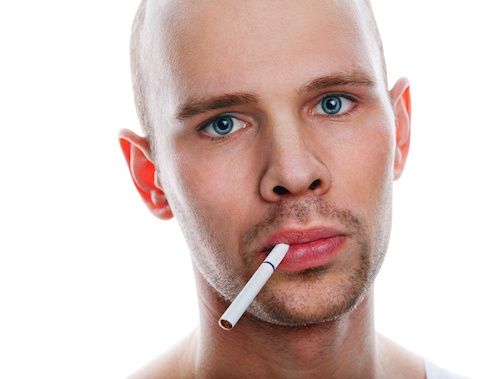
You may be blaming your genes for going bald early, but could it be a reversible trigger? There are many temporary causes for hair loss that once improved or ceased can lead to your hair growth returning to normal.
Under normal circumstances, we all shed around 50-100 hairs a day as part of the usual hair growth and renewal cycle. In times of stress or when health is weakened, loss can accelerate and the normal hair growth cycle can be disrupted. We discuss the impact that smoking has on the hair growth and renewal cycle and what you can do if you are unsure of the cause of your onset of balding.
If you suffer from hair loss, answer these 3 questions to discover the best treatment option for you.
The Hair & Smoking Relationship
It has long been speculated that cigarette smoke may fast-track the balding process. Recent studies have shown that suspicions on the toxins in smoke and the harm they can do to hair follicles, as well as damage to hormones, were accurate. During a study of 600 men and women, 50% of them smokers, a significant and consistent link between smoking and hair loss was established. Research shows that cigarette smoke disrupts the normal hair growth cycle by negatively effecting your circulation. Smoking impairs the blood flow to your hair follicles, reducing the amount of oxygen and increasing the level of carbon monoxide, causing damage to the hair follicle. Your hair will thin and eventually this leads to loss of hair.
Additionally, the toxic chemicals from smoking cigarettes starves the follicles of its essentials. The health of the follicle is as vital for hair growth as soil is for a plant to grow. Hair follicles require a good supply of oxygen, essential nutrients, vitamins and minerals to function properly and trigger hair growth. When follicles are deprived of oxygen, vitamins and nutrients, hair growth is negatively impacted.
Other common triggers for hair loss in women include; pregnancy, thyroid disorders, anaemia, polycystic ovary syndrome, psoriasis and seborrheic dermatitis.
What Can I Do To Stop Hair Loss?
Everyone can benefit from improving their health. If you can stop smoking or at least try to reduce smoking, this will help to improve the health of your hair follicles to assist the improvement of hair growth. We know that stress is a key contributor to hair loss, so stopping or reducing smoking that leads to increased stress levels may counteract your efforts. Support from your health professional is recommended. If you can stop or limit smoking, reduce stress and improve your diet, you may be able to reverse your loss without further treatment, or improve the success of any treatment you may need.
Step 1 – A Correct Diagnosis
At Gro we know that a correct diagnosis is the foundation for successful and permanent treatment for hair loss. Our Total Care System is the most sophisticated diagnosis system and provides an accurate and personalised diagnosis for all types of hair and scalp disorders including Alopecia.
The Total Care System is broken down into four steps;
- Psychology Aspect – we take on a psychological investigation of every patient suffering from hair loss and scalp disorders at Gro. This allows us to determine the necessity of combinatorial access of these conditions and any underlying psychopathology.
- Mathematical Aspect – during this stage we evaluate the patient’s donor zone and its eligibility for the session. Following this we will recommend the size of the hair transplant section.
- Artistic Aspect – During this stage we discuss the design of the new hairline as well as coverage and hair density.
- Medical Aspect – Finally we discuss Gro micro-transplant, complete a health questionnaire and prevention of future hair loss.
Once we have completed these steps we will know if the trigger is something that is reversible, like smoking, or if further action will need to be taken in order to restore your hair growth.
If the trigger is not reversible and further action is required, for example, a hair transplant, Gro offers the least invasive and most delicate procedure with 100% natural results guaranteed. The Direct Hair Implantation technique implants hair follicles one by one, directly into the areas that are thinning. Every follicle is specifically placed in the correct direction, angle and depth using our implanter tool to guarantee natural results. Once the procedure is complete, the hair follicles will continue to grow throughout a patient’s life.
During extraction and implantation, our specially designed tools makes incisions with a diameter of 1mm or less. This means that your downtime is minimal, in most cases clients even return to work the following day.
Next Step
Gro treatment options are personalised to individual requirements, based on sound medical knowledge and experience. If you are worried about losing your hair, or have been thinking about getting treatment, come in for a consultation with a Gro hair growth specialist. We can give you an accurate diagnosis and answer any questions you have about what treatment options are right for you.
For further information or to book your medical hair diangnosis, call Gro Australia on 1300 787 563.












